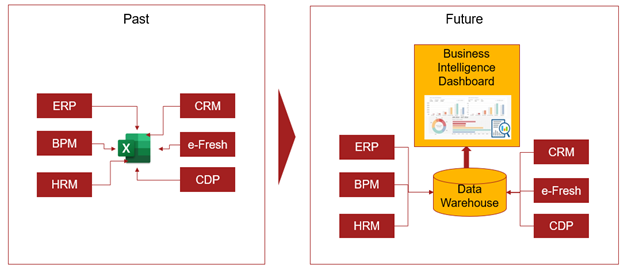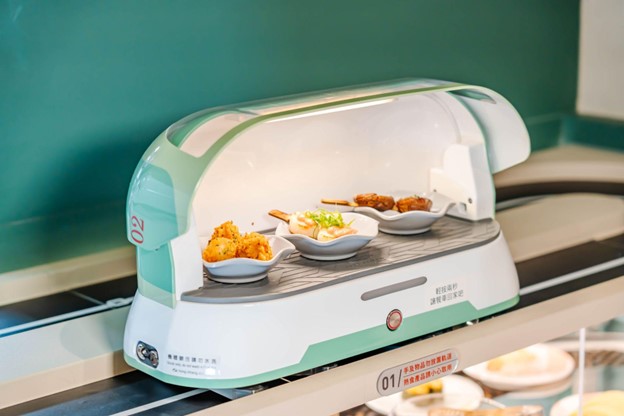Economy & Business
Sushi Express: Fighting for freshness
Sushi Express maintains its position as Taiwan's leading sushi brand and continuously expands internationally through digital transformation
Courtesy of PwC
Organization background
Founded in Taiwan in 1996, Sushi Express Group (hereafter referred to as Sushi Express) expanded internationally in 2006 and now operates over 650 stores across the Asia-Pacific region. Today, it holds the largest market share in Taiwan's sushi chain sector.
Despite its cost advantages and strong market share, Sushi Express faced several challenges in driving its digital transformation. Fluctuating supply chain issues and labor shortages have affected profitability, while shifting consumer behaviors—especially the growing demand for online services—required Sushi Express to enhance its digital experience. As the company expands in Asia, improving multinational management efficiency becomes essential to sustain growth and increase revenue in international markets.

Fig. 1: Sushi Express provides fresh dishes with multiple digital services.
Digital transformation approaches
In its approach to digital transformation, Sushi Express has planned three digital transformation strategies: 1) Enhance operational efficiency, 2) Provide diverse customer experiences, and 3) Integrate the vertical supply chain.

Fig. 2: Digital Transformation Solution to Sushi Express
1. Enhance operational efficiency
In 2021, Sushi Express Group implemented an SAP Enterprise Resource Planning system (ERP) and a Business Process Management system (BPM), followed by the implementation of a Human Resource Management system (HRM) in 2023. That same year, the ERP system was rolled out to its branch in China. The ERP system manages core operational activities, the BPM system oversees business processes, while the HRM system enhances human resource management efficiency.
Through the ERP system, Sushi Express reduced the accounting closure time from 15 days to 10 days.
Building Digital Backbone: ERP, BPM, and HRM systems
Managing a complex supply chain that includes production facilities, central kitchens, and multiple restaurants, Sushi Express implemented an ERP system to integrate operational data and provide real-time reports that enhance decision-making in procurement and logistics. This system also coordinates production and sales by managing order demands, ensuring a stable stock of ingredients. Additionally, the ERP system enhances financial transparency, allowing for better cost control and cash flow management.
Moreover, by adopting a BPM system, Sushi Express standardized business processes, minimizing risks and errors while increasing efficiency. Electronic signature processes will streamline information flow and automate reminders, ensuring that all business processes are completed efficiently.
To improve human resource management, Sushi Express also implemented an HRM system that automated administrative tasks within the HR department, allowing staff to focus on more strategic activities such as recruitment and training. The system can also automate scheduling based on store hours and staff availability, enhancing management efficiency and reducing scheduling errors.
Data Warehouse Facilitates Business Intelligence (BI) Analysis
In 2023, Sushi Express established a Data Warehouse to integrate cross-system data for business intelligence (BI) analysis, providing a foundation for operational and sales decision-making. Previously, data connections relied on point-to-point transfers, creating decision gaps due to a lack of overall visibility. Now, with a centralized Data Warehouse, all system data is integrated, enabling the creation of tailored data marts for BI tools to access and analyze.
With the implementation of the ERP and BI systems, report generation has transitioned from taking five days to providing real-time information, thereby enhancing decision-making and operational responsiveness.

Fig. 3: System Architecture of Data Warehouse and Business Intelligence Dashboard
2. Provide Diverse Customer Experiences
To meet diverse customer needs, Sushi Express launched several digital services and created One ID for each member, collecting comprehensive member data. This approach provides clear consumer profiles, enabling targeted marketing strategies that improve conversion rates and increase sales.
Digital Services enhance customer experience
From 2022 to 2023, Sushi Express introduced multiple digital services to optimize the customer experience. By introducing an online reservation system, customers can book tables in advance, significantly reducing wait times and allowing for better meal planning.
Once inside the restaurant, the integration of online self-ordering, Meal Management System, and automated delivery carts further improves the dining experience. Customers can place their orders digitally, which generates tickets for the kitchen and utilizes automated carts for delivery. This process is linked to the POS system, allowing for efficient checkout.

Fig. 4: Sushi Express enhances the dining experience for customers by using automated delivery carts.
Digital Marketing for Effective Customer Relationship Management
Sushi Express has enhanced its customer relationship management through a membership app and integrated Customer Relationship Management system (CRM) launched in 2022. The app consolidates features such as reservations, ordering, and promotions across various brands to provide a seamless customer experience. Through the CRM system, Sushi Express tracks member interactions and preferences, enabling personalized communication and offers. This initiative has attracted over 1.5 million app users, with membership contributing more than 30% of total revenue.
To further improve marketing efforts, Sushi Express has implemented a Customer Data Platform (CDP) that integrates consumer data into a unified platform, providing a comprehensive 360-degree view of consumer behavior. The CDP delivers real-time data updates and offers diverse analytical perspectives, such as customer journey analysis and predictive analytics, enabling Sushi Express to extract insights from data and tailor its marketing campaigns.
By integrating the CDP and CRM, Sushi Express enhances customer relationships and boosts marketing conversion rates. Currently, the project is ongoing, with the CDP implementation complete, and enhancements to both the CDP and CRM planned for 2024-2025, including advanced consumer behavior analysis, tagging features, and marketing automation to refine marketing precision.
3. Integrate the vertical supply chain
As the next step in its digital transformation, Sushi Express plans to focus on integrating its vertical supply chain. This will involve establishing smart factories and creating a unified procurement platform. These initiatives aim to build a supply chain ecosystem that enhances stability and supports the company’s expansion from the Asian market to a global presence.
Smart Factory enables automation and real-time management
Sushi Express plans to implement smart production lines and automated warehousing to enhance production capacity and meet the growing order demands from expanding stores. The integration of Manufacturing Execution System (MES) and ERP systems will automate scheduling and resource management, while robots and IoT technology will allow real-time monitoring of production processes. For shipping, the integration of ERP and Automated Storage and Retrieval System (AS/RS) will enable automated and real-time inventory management, enhancing procurement decision-making and increasing inventory turnover.
Establishing a Global Unified Procurement Platform
To build a supply chain ecosystem, Sushi Express plans to establish a "Global Unified Procurement Platform." This initiative aims to attract both the foodservice industry and suppliers through two key strategies: creating win-win scenarios and ensuring demand transparency.
By consolidating wholesale raw material needs from its global stores, Sushi Express will shift from decentralized to centralized purchasing, thereby improving bargaining power, lowering unit procurement costs, and reducing wholesale prices to benefit industry peers. Additionally, by analyzing sales data, inventory levels, and replenishment cycles, Sushi Express will generate inventory demand forecasts and share this information with suppliers, enabling them to enhance stocking efficiency and reduce inventory costs.
Critical success factors
Sushi Express's digital transformation success hinges on three key factors. The first is clear business goals and commitment to transformation. The leadership team at Sushi Express is fully committed to digital transformation, investing heavily in technology and resources. They've restructured organizational culture and employee training, aligning clear digital strategies with departmental KPIs. This ensures consistency across the organization, emphasizing that digital transformation is a collective effort, not just a task for the tech department.
The second is digital transformation from the inside out to mitigate execution risks. The transformation began by enhancing internal operational systems, allowing employees to adapt to digital tools before extending to customer-facing systems. This approach reduces risks and costs associated with large-scale changes. By learning and adapting internally, the company minimizes potential errors and inconveniences when interacting with customers.
The third key success factor is efficient digital dissemination. Sushi Express has built a robust digital backbone, integrating data across various systems to create centralized platforms, including a data warehouse and a customer data platform. This foundation improves data efficiency and scalability. Utilizing technologies like AWS, the company ensures its systems can adapt to different market needs while maintaining high integration levels. After successfully implementing its system in Taiwan, Sushi Express is now applying these lessons to its overseas branches, particularly in China, while continuously refining its systems based on partner insights.
Lessons learned
To sum up, Sushi Express's transformation from a local player to a global presence offers three key lessons. Firstly, Sushi Express established a solid digital foundation while embedding a data-driven culture within the organization. Viewing implemented systems as tools for efficiency and opportunities for growth, Sushi Express fostered cross-departmental communication and process reengineering, enhancing employee engagement. This digital infrastructure increased transparency and empowered staff to make informed decisions, gradually cultivating a culture supportive of global expansion.
Secondly, emphasizing that digital technology should enhance rather than disrupt the customer experience, Sushi Express maintained a commitment to human interaction in service. Staff guide customers through online ordering systems and automated delivery, ensuring understanding before leaving. By prioritizing customer needs, the company ensured that digital transformation improved internal operations while enhancing consumer satisfaction.
Lastly, by integrating a supply chain ecosystem, Sushi Express aims to attract partnerships with other food service providers, creating a mutually beneficial environment. This collaboration enhances supply chain resilience and competitiveness, demonstrating the importance of inter-company cooperation in the digital age and providing valuable insights for other businesses.